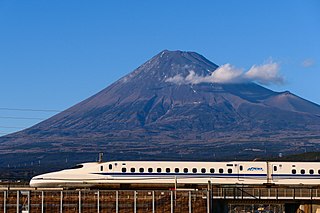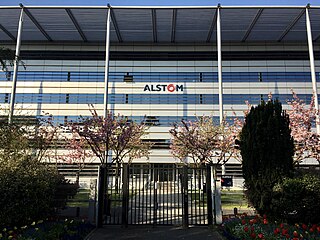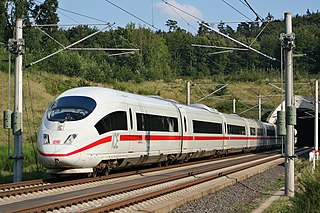
High-speed rail (HSR) is a type of rail transport network utilizing trains that run significantly faster than those of traditional rail, using an integrated system of specialized rolling stock and dedicated tracks. While there is no single standard that applies worldwide, lines built to handle speeds above 250 km/h (155 mph) or upgraded lines in excess of 200 km/h (125 mph) are widely considered to be high-speed.

The TGV is France's intercity high-speed rail service. With commercial operating speeds of up to 320 km/h (200 mph) on the newer lines, the TGV was conceived at the same period as other technological projects such as the Ariane 1 rocket and Concorde supersonic airliner; sponsored by the Government of France, those funding programmes were known as champion national policies. In 2023 the TGV network in France carried 122 million passengers.

A tilting train is a train that has a mechanism enabling increased speed on regular rail tracks. As a train rounds a curve at speed, objects inside the train experience centrifugal force. This can cause packages to slide about or seated passengers to feel squashed by the outboard armrest, and standing passengers to lose their balance. In such excessive speeds, it could even cause the train to derail. Tilting trains are designed to counteract this by tilting the carriages towards the inside of the curve, thus compensating for the g-force. The train may be constructed such that inertial forces cause the tilting, or it may have a computer-controlled powered mechanism.

Alstom SA is a French multinational rolling stock manufacturer which operates worldwide in rail transport markets. It is active in the fields of passenger transportation, signaling, and locomotives, producing high-speed, suburban, regional and urban trains along with trams.

Intercity Express is a high-speed rail system in Germany. It also serves destinations in Austria, France, Belgium, Switzerland and the Netherlands as part of cross-border services. It is the flagship of the German state railway, Deutsche Bahn. ICE fares are fixed for station-to-station connections, on the grounds that the trains have a higher level of comfort. Travelling at speeds up to 300 km/h (190 mph) within Germany and 320 km/h (200 mph) when in France, they are aimed at business travellers and long-distance commuters and marketed by Deutsche Bahn as an alternative to flights.

A streamliner is a vehicle incorporating streamlining in a shape providing reduced air resistance. The term is applied to high-speed railway trainsets of the 1930s to 1950s, and to their successor "bullet trains". Less commonly, the term is applied to fully faired upright and recumbent bicycles. As part of the Streamline Moderne trend, the term was applied to passenger cars, trucks, and other types of light-, medium-, or heavy-duty vehicles, but now vehicle streamlining is so prevalent that it is not an outstanding characteristic. In land speed racing, it is a term applied to the long, slender, custom built, high-speed vehicles with enclosed wheels.

The TGV La Poste were dedicated trainsets for high-speed freight and mail transportation by French railway company SNCF on behalf of the French postal carrier La Poste. The top speed of this TGV Sud-Est derivate was 270 km/h (168 mph), making them the fastest freight trains in the world. They were withdrawn in 2015.

The world record for a conventional wheeled passenger train is held by a modified French TGV high-speed code named V150, set in 2007 when it reached 574.8 km/h (357.2 mph) on a 140 km (87 mi) section of track. Japan's experimental maglev train L0 Series achieved 603 km/h (375 mph) on a 42.8 km (26.6 mi) magnetic levitation track in 2015.

The TGV Duplex is a French high-speed train of the TGV family, manufactured by Alstom, and operated by the French national railway company SNCF. They were the first TGV trainsets to use bi-level passenger carriages with a seating capacity of 508 passengers, increasing capacity on busy high-speed lines. While the TGV Duplex started as a small component of the TGV fleet, it has become one of the system's workhorses.
The TGV is France's high-speed rail service. The idea of a high-speed train in France was born about twenty years before the first TGVs entered service. At that time, about 1960, a radical new concept was thought up; combining very high speeds and steep grades would allow a railway to follow the contours of existing terrain, like a gentle roller coaster. Instead of one or two percent grades which would be considered steep in normal applications, grades up to four percent would be feasible, thus allowing more flexible routing of new lines. Over the next several years, this very general idea gave rise to a variety of high speed transportation concepts, which tended to move away from conventional "wheel on rail" vehicles. Indeed, the French government at the time favoured more "modern" air-cushioned or maglev trains, such as Bertin's Aérotrain; Steel wheel on rail was considered a dead-end technology. Simultaneously, SNCF was trying to raise the speeds of conventional trains into the range 180 to 200 km/h for non-electrified sections, by using gas turbines for propulsion. Energy was reasonably cheap in those years, and gas turbines were a compact and efficient way to fulfil requirements for more power. Following on the TGS prototype in 1967, SNCF introduced gas turbine propulsion with the ETG turbotrains in Paris - Cherbourg service, in March 1970.

Siemens Velaro is a family of high-speed electric multiple unit trains built by Siemens. It is based on the ICE 3 high-speed trains initially co-manufactured by Siemens and Bombardier for German national rail operator Deutsche Bahn (DB).

The ICE 2 is the second series of German high-speed trains and one of six in the Intercity-Express family since 1995. The ICE 2 (half-) trains are even closer to a conventional push–pull train than the ICE 1, because each train consists of only one locomotive, six passenger cars and a cab car. The maximum speed is 280 km/h (175 mph), but this is limited to 250 km/h (155 mph) when the cab car is leading the train and even further down to 160 km/h (100 mph) when two units are coupled at the powerheads due to the forces on the overhead line by their respective pantographs.

SNCF's CC 7100 class are part of a series of electric locomotives built by Alstom. The prototype 'CC 7000' were built in 1949 and the production series locomotives CC 7101-CC 7158 followed during 1952–1955. Two of the class are notable for setting world rail speed records: CC 7121 reaching 243 kilometres per hour (151 mph) on 21 February 1954, and CC 7107 reaching 331 kilometres per hour (206 mph) on 28/29 March 1955.

The Madrid–Barcelona high-speed rail line is a 621-kilometre (385.9 mi) standard gauge railway line inaugurated on 20 February 2008. Designed for speeds of 350 km/h (217.5 mph) and compatibility with neighbouring countries' rail systems, it connects the cities of Madrid and Barcelona in 2 hours 30 minutes. In Barcelona the line is connected with the Perpignan–Barcelona high-speed rail line leading into France which connects it to the European high speed network.

The Renfe Class 130 or S-130 is a high-speed dual-gauge, dual-voltage trainset consisting of 11 Talgo VII tilting coaches and two power cars, used on Alvia and Euromed services. The class have been nicknamed patitos (ducklings), due to the shape of the train nose.

The KTX-I, also known as the TGV-K or Korail Class 100000, is a South Korean high speed train class based on the French TGV Réseau. The 20-car formation of the trainsets without a restaurant car is optimized for high capacity. The 46 trainsets were built partly in France and partly in South Korea in the framework of a technology transfer agreement, which was the basis for further domestic high-speed train development in South Korea.
Eurotrain was a joint venture formed by Siemens and GEC-Alstom to market high-speed rail technology in Asia. In 1997 it was one of two competitors to supply the core system of Taiwan High Speed Rail (THSR), and it was awarded the status of preferred bidder by concessionaire THSRC. Eurotrain assembled a demonstration train, but later THSRC decided to award the contract to a rival consortium, leading to a legal battle ending in damage payments for Eurotrain in 2004.

The Mont Cenis was an international express train linking Lyon in France with Milan in Italy. The train was named after the mountain range through which it crossed, inside the Fréjus Rail Tunnel on the French-Italian border.
Le Frecce is the high-speed rail train category operated by Trenitalia in Italy under overall three brand names.

The first-generation Acela Express trainset is a unique set of vehicles used on the Acela, Amtrak's flagship high-speed service along the Northeast Corridor (NEC) in the Northeastern United States. When they debuted in 2000, the sets were the fastest in the Americas, reaching 150 mph (240 km/h) on 33.9 mi (54.6 km) of the route. They were built between 1998 and 2001 by a consortium of Alstom and Bombardier. Each set has two power cars derived from units that Alstom built for the TGV, and six passenger cars derived from the LRC that Bombardier built for Via Rail.
















